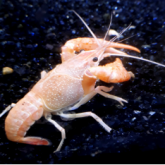Red swamp crayfish

Red swamp crayfish in aquarium
© Queensland Government

Red swamp crayfish in the wild
© Joaquim Gaspar Creative Commons
Red swamp crayfish are an aquatic species of cambarid freshwater crayfish, native to northern Mexico and south eastern United States.
You must not keep, feed, move, give away, sell or release into the environment. Penalties may apply.
You must report all sightings to Biosecurity Queensland within 24 hours.
Scientific name
Procambarus clarkii
Description
- 5–12cm long.
- Weigh up to 50g.
- Usually dark red in the wild, and light red in aquaria.
- Claws and head are elongated.
- Small spines may be present on the sides of the carapace below the head.
- Rows of brightly coloured red bumps on the front and side of the first leg are characteristic to the species.
Habitat
- Found in warm freshwater rivers and creeks.
Distribution
- Native to northern Mexico and south eastern United States; have established in other countries as an invasive species.
- Have been seized from aquariums in Queensland.
- No confirmed spread to native waterways in Australia.
Life cycle
Breeding
- Grow quickly, reaching maximum age around 5 years.
- Reproduce sexually, but new evidence suggests they may also reproduce by parthenogenesis.
Diet
- Snails, fish, amphibians and plants.
Impacts
- Will outcompete native crayfish species if introduced into Australian freshwater ecosystems.
- Carrier of the destructive crayfish plague disease (Aphanomyces astaci—also prohibited under the Biosecurity Act 2014).
- Carrier of the crayfish virus vibriosis, and various species of worms that are parasitic on vertebrates.
- Burrowing can damage watercourses and crops.
Control
- If you see or are in possession of a red swamp crayfish, contact our Customer Service Centre within 24 hours or use our online reporting form. Take photos and keep captured specimens frozen, if possible, to help us with further identification.
Legal requirements
- Red swamp crayfish are prohibited matter under the Biosecurity Act 2014. You must not keep, feed, move, give away, sell or release into the environment. Penalties may apply.
- You must not take any action reasonably likely to exacerbate the biosecurity threat posed by red swamp crayfish.
- You must take any action that is reasonably likely to minimise the biosecurity threat posed by red swamp crayfish.
- You must report all sightings to Biosecurity Queensland within 24 hours.